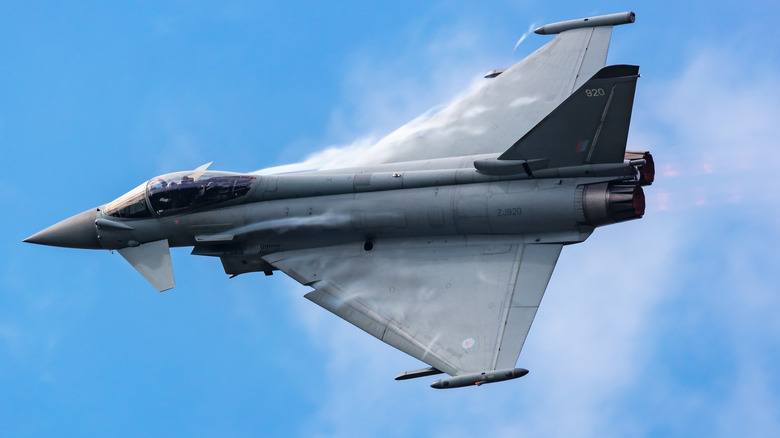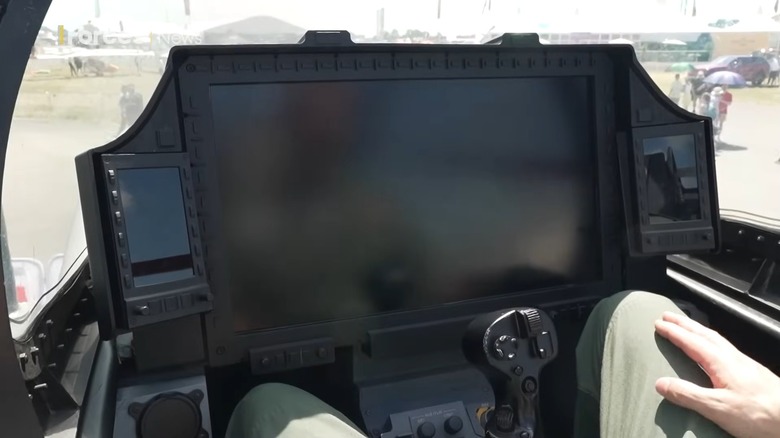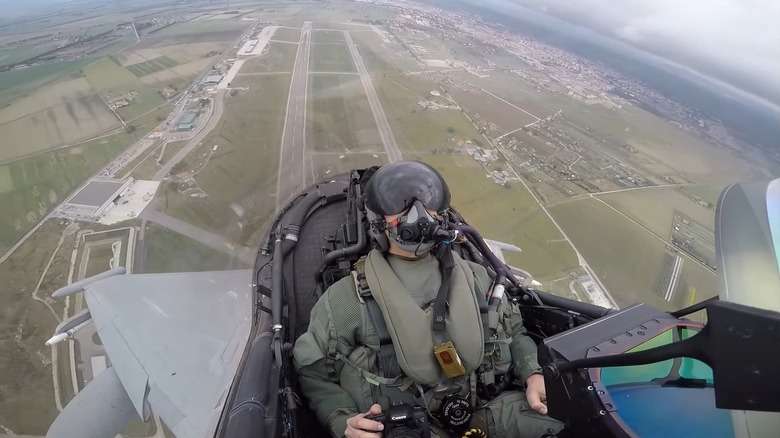What Does The Inside Of A Eurofighter Typhoon Jet Look Like?
Actively in service with many European military forces, the Eurofighter Typhoon is one of the best fighter planes and jets of all time. However, if you were suddenly thrown into the cockpit of this 4.5 generation fighter aircraft, without extensive training, overwhelmed would likely be the best word to describe your experience. The first thing you might notice is the large oval-shaped HUD (heads-up display), at eye level directly in front of you. This HUD provides real-time data, such as flight vector, targeting, and weapon sensors, which are visible in the Typhoon even when using night vision or laser eye protection.
Among the myriads of buttons and dials as you scan below the HUD, you'll see the Eurofighter's MHDD (multi-function head down displays). Essentially, this system is comprised of three square screens for the pilot to glean crucial data. The Typhoon MHDD can be set up manually, or it can automatically select the appropriate configuration from various formats to fit different mission requirements.
Another major component of the Eurofighter's cockpit is the HOTAS (hands-on throttle and stick), which allows the pilot to control the movement of the jet precisely. However, this jet incorporates DVI (direct voice input), transforming it from a HOTAS to a VTAS (voice, throttle, and stick) system. This allows various tasks to be completed with vocal commands rather than relying on a co-pilot, needing to release the stick, or look away from the HUD during intense situations.
This potential cockpit upgrade could make flying the Eurofighter easier
This remarkable jet has been around for more than three decades, and while the Eurofighter Typhoon has features that make it one of the best fighter jets ever built, there is always room for improvement. Case in point, the MHDD system in the cockpit is perhaps a bit dated. Each of the three displays measures six inches by six inches, which has been described as relatively small. It also doesn't help that these displays don't offer a particularly high resolution. Essentially, as the aircraft's role over the years has expanded beyond its initial air-to-air designation, these compact lower-resolution displays haven't lent themselves well to other types of missions.
One proposed upgrade that would significantly improve this aspect of the Typhoon's cockpit is to install a massive center display that would take up the entire dashboard. The argument is that with the Typhoon taking on additional duties like air-to-surface roles and electronic warfare with enhanced radar systems, they need more screen real estate. Without a larger display, the pilot would have to fiddle with zoom settings and different layout options just to be able to see everything going on.
What's it like to fly in the Typhoon?
Those who have sat in the Eurofighter's cockpit and taken to the air have remarked on the incredible visibility offered. You might think that the canards, which look like small wings protruding just below the canopy, would be an obstruction, but pilots have reported otherwise. Of course, the sheer power of this jet is also frequently a topic among pilots with experience in the Typhoon's cockpit.
Stories of this jet becoming airborne after racing down the runway for only six seconds, and others describing the impressive performance of the Typhoon's massive engines when scrambling to intercept non-compliant aircraft, speak to its potent capabilities. Pilots have also described a middle-of-the-night scramble siren jolting them awake, and in fewer than 15 minutes, they are hitting Mach one at 40,000 feet. This highly capable fighter jet can easily pull 5 G's during turns, which isn't surprising considering the Eurofighter Typhoon's top speed.
Behind the pilot, the backseat is spacious and ergonomic. Where the rear seat really excels is in greater visibility and situational awareness via a second wide-angle HUD, displaying identical information as the pilot's HUD is showcasing. In addition, there is a video feed providing the co-pilot a forward view that's ordinarily blocked by the pilot's ejection system. Essentially, these additions to the rear seat provide an experience much closer to that of the pilot's.


